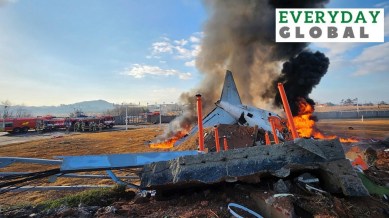South Korea Plane Crash leaves 179 people dead: How do bird strikes impact flights?
South Korea Plane Crash News Update: Bird strikes are being examined as a possible reason behind the recent aeroplane accident in South Korea. How do bird strikes become a safety hazard for flights? We explain.

South Korea Plane Crash: All passengers except two crew members of a flight were killed in an aviation accident in South Korea on Sunday (December 29), when an aircraft skidded off the runway during landing, hit a wall and burst into flames at the Muan International Airport.
The Jeju Air flight 7C2216 was arriving from the Thai capital Bangkok to Muan, nearly 300 km from the capital Seoul, with 181 people on board. With only two people rescued from the tail section of the aircraft, 179 people were reported dead. Given the death toll, it is among the country’s biggest aviation accidents to date.
Lee Jeong-hyeon, chief of the Muan fire station, said in a televised briefing that workers were looking into various possibilities about what caused the crash, including whether the aircraft was struck by birds, he said.
Korean media agency Yonhap also cited airport authorities as saying a bird strike may have caused the landing gear to malfunction. A transport ministry official has said the control tower issued a bird strike warning and shortly afterwards the pilots declared mayday. However, it is not confirmed yet whether the flight said it struck any birds.
But how exactly do bird strikes impact planes? We explain.
What are bird strikes and what can happen as a result of a strike?
Bird strikes are among the most common threats to aircraft safety, and they typically occur during the take-off or landing phases of a flight. Dozens of bird strike incidents happen each day but some can be more dangerous than others. Typically, when birds collide with an aircraft’s airframe, it is unlikely to cause significant problems for the pilots flying.
But there are cases where the aircraft engine has ingested birds, causing damage to the power plants. This can lead to a loss of thrust for the engine and cause manoeuvrability problems for the crew. In these cases, where a jet engine ingests a bird, procedures would generally call for pilots to get the plane on the ground at the closest airport.
However, while most airframe bird strikes are not considered critical to air safety, if the collision has happened with a window or a windscreen resulting in cracking of the structure, pilots will look to land the plane as early as possible.
Among the most famous recent cases of a bird strike was in 2009, when less than a minute after US Airways flight 1549 flight left New York’s LaGuardia airport for North Carolina, Captain Chelsey Sullenberger told air controllers both the plane’s engines had been broken by a flock of birds.
A BBC report noted, “He had only moments to make the decision on whether to try to make it to the airport runway or make the risky landing on the River Hudson. Realising he wouldn’t make the runway he chose the river, hitting the minus seven degrees water at 140 mph.”
All 155 passengers and crew survived the impact.
Could bird strikes be critical to air safety?
Smaller planes would generally be more susceptible to the dangers of bird strikes than larger ones. Also, modern jetliners are built with a number of redundancies and common passenger aircraft like Boeing 737 or Airbus A320 are designed to safely land with even a single engine.
However, given that bird strikes mostly happen during take-offs and landings, these incidents could distract the pilots during what are highly critical phases of a flight that demand the complete attention of the crew.
What causes bird strikes and what are some of the solutions to this problem?
In the simplest of terms, the presence of birds around an airfield increases the chances of a bird strike. In monsoons, as water puddles emerge in open grounds attracting insects to breed, it also increases the presence of birds in these regions.
In some cases, bird hits also happen at higher altitudes when a plane is cruising. These are more dangerous than the low-altitude hits given that they can cause rapid depressurisation of cabins. Other reasons for bird activity around an airfield could be the presence of landfills or waste disposal sites that attract a large number of birds.
For example, in 2019, the Ahmedabad airport saw 11 wildlife strike events every 10,000 flights. One of the key reasons behind this was the dismantling of a large garbage dump in Ahmedabad that was located almost directly in the trajectory of flights approaching the airport, a move that has caused the birds circling the landfill to disperse.
India’s Ministry of Civil Aviation and the Directorate General of Civil Aviation (DGCA) has recognised wildlife strikes, including bird and animal hits, to aircraft as one of the “State Safety Priority”, and the aviation regulator regularly carries out aerodrome inspections that are considered critical with regard to wildlife strikes. Aviation authorities, along with local agencies, work on reducing wildlife presence around airports from time to time.
A recent report in The Conversation further said, “The two largest manufacturers of passenger jets, Boeing and Airbus, use turbofan engines. These use a series of fan blades to compress air before adding fuel and flame to get the thrust needed to take off. Bird strikes in one of these engines can cause severe damage to the fan blades, causing the engine to fail. Engine manufacturers test the safety of these engines by firing a high-speed frozen chicken at them while the engine is operating at full thrust.”
(With wire inputs. This is an updated version of an explainer first published in 2022.)